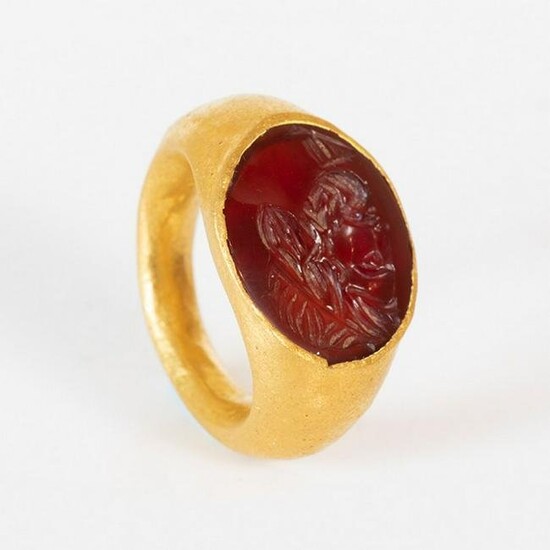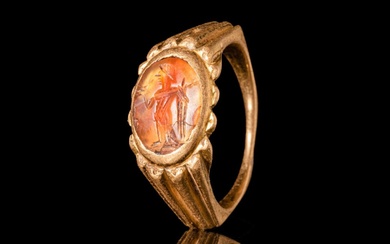Ring with carving. Roman culture, 1st-2nd century AD.
Ring with carving. Roman culture, 1st-2nd century AD.
Gold and garnet.
Provenance: Iconastas, Piccadilly Arcade, St. James's, London.
Weight : 10,55 gr.
Measurements : 30mm. (outer diameter); 18 mm. (inner diameter); 19 mm. (height of setting).
Roman ring with a hollow gold ring, wider towards the front, where it houses in a closed setting a garnet carved in a hollow, like a seal, oval in shape, with a figurative representation.
In the Roman Empire there was a great fondness for the ornamentation of stones, both carvings and cameos. The patrician families possessed large collections of these pieces, and after the fall of the empire the barbarians integrated them into their own treasures, passing them down from generation to generation (mostly in the Germanic area) until the time of Charlemagne, the Holy Roman Empire, etc. In fact, Alfonso X the Wise had an important collection of Roman carved stones, which he inherited from his mother, Beatrice of Swabia. Within Roman jewellery, the most commonly used stones were emerald, garnet, amethyst, sapphire and rock crystal, and the pieces are generally simple, the beauty of which lies in the quality of the materials and, if present, the setting.
Estimate
Time, Location
Auction House
Ring with carving. Roman culture, 1st-2nd century AD.
Gold and garnet.
Provenance: Iconastas, Piccadilly Arcade, St. James's, London.
Weight : 10,55 gr.
Measurements : 30mm. (outer diameter); 18 mm. (inner diameter); 19 mm. (height of setting).
Roman ring with a hollow gold ring, wider towards the front, where it houses in a closed setting a garnet carved in a hollow, like a seal, oval in shape, with a figurative representation.
In the Roman Empire there was a great fondness for the ornamentation of stones, both carvings and cameos. The patrician families possessed large collections of these pieces, and after the fall of the empire the barbarians integrated them into their own treasures, passing them down from generation to generation (mostly in the Germanic area) until the time of Charlemagne, the Holy Roman Empire, etc. In fact, Alfonso X the Wise had an important collection of Roman carved stones, which he inherited from his mother, Beatrice of Swabia. Within Roman jewellery, the most commonly used stones were emerald, garnet, amethyst, sapphire and rock crystal, and the pieces are generally simple, the beauty of which lies in the quality of the materials and, if present, the setting.





